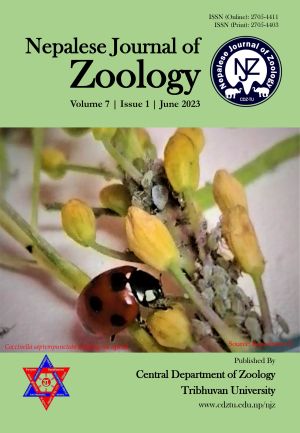Feeding efficiency of Coccinella septempunctata Linnaeus and Propylea luteopustulata (Mulsant) against Mustard aphid Lipaphis erysimi (Kaltenbach)
DOI:
https://doi.org/10.3126/njz.v7i1.56304Keywords:
Agroecosystems; Aphidophagy; Coccinellid; Ladybird beetle; Biological controlAbstract
Ladybird beetles are efficient natural predators of aphids, particularly the ladybird beetles are efficient natural predators of aphids, particularly the widespread mustard pest, Lipaphis erysimi. This study compared the feeding efficiency of two adult predator ladybird beetle species Coccinella septempunctata and Propylea luteopustulata against L. erysimi in an experimental set-up for forty-nine days from 29 December 2019 to 15 February 2020. Five replicates of each beetle species were supplied with 100 aphids daily and their feeding rate was counted. Negative binomial regression analysis of these predator beetles showed that C. septempunctata consumed a significantly high number of mustard aphid individuals (29.42 ± 1.33) than P. luteopustulata (23.20 ± 1.07) at room temperature and relative humidity. Temperature and relative humidity also influenced the feeding rate of these beetles. The feeding rate of P. luteopustulata against a mustard pest aphid is described for the first time. The findings of the study will be an important aspect in the biological control of pests in Nepalese agroecosystems.
Downloads
Downloads
Published
How to Cite
Issue
Section
License

This work is licensed under a Creative Commons Attribution-NonCommercial 4.0 International License.
This license enables reusers to distribute, remix, adapt, and build upon the material in any medium or format for noncommercial purposes only, and only so long as attribution is given to the creator.

